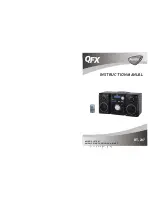
AD1849K
REV. 0
–21–
DCB = “0” until the echoed DCB from the Codec also is reset
to “0” (i.e., it must poll DCB until a “0” is read). This is the
first interlock of the DCB handshake.
The DCB = “0” is echoed on SDTX in the next frame after it
was received on SDRX if a sample rate has been consistently
selected AND the clock source is generated using the internal
oscillator. Otherwise DCB = “0” will be echoed on SDTX in
the frame after at least 2 ms of consistent sample rate selection
expires. If SCLK or CLKIN is used as the clock source, the user
must guarantee that the source selection and sample rate are
stable for 2 ms before D/
C
is driven HI.
Note that after sending a Control Word with DCB = “0,” the
external controller must take care not to set (or glitch) DCB =
“1” until after the echoed DCB = “0” has been received from
the Codec.
Second DCB Interlock
After it sees the DCB = “0” (and has optionally verified that the
echoed Control Word is correct), and when it is ready to
continue with the DCB handshake, the external controller
should transmit the desired and valid control information, but
now with DCB set to “1.” The external controller can then
transmit arbitrary control information until the echoed DCB
from the Codec is also set to “l” (i.e., it must poll DCB until a
“l” is read). After this Control Word with DCB = “1,” all future
control information received by the Codec during Control
Mode (i.e., while D/
C
is LO) will be ignored. This is the second
and final interlock of the DCB handshake.
The Codec will echo DCB = “l” in the next frame after it was
received on SDRX if a sample rate has been consistently
selected AND the clock source is generated using the internal
oscillator. Otherwise DCB = “1” will be echoed on SDTX once
one sample rate selection has been held constant for at least
2 ms. If SCLK or CLKIN is used as the clock source, the user
must guarantee that the source selection and sample rate are
stable for 2 ms before D/
C
is driven HI. The Codec will
transmit the full 64-bit Control Word with DCB = “1” and then
three-state the SDTX pin. The external controller must
continue to supply SCLK to the Codec until all 64 bits of the
Control Word with DCB = “1” have been transmitted by the
Codec, plus at least one [1] more SCLK after this 64-bit
Control Word (i.e., at least 65 SCLKs). Note that echoing the
full 64-bit Control Word makes the AD1849K match the
behavior of the CS4215.
Exit Control Mode
Control mode DCB handshake is now complete. The Codec
will remain inactive until D/
C
goes HI or
RESET
and or PDN
are asserted.
Note that if a sample rate and a clock source have been
consistently selected throughout the handshake, the AD1849K
and the CS4215 DCB protocols are equivalent.
Control Mode to Data Mode Transition and Autocalibration
The AD1849K will enter Data Mode when the asynchronous
D/
C
signal goes HI. The serial interface will become active
immediately and begin receiving and transmitting Data Words
in accordance with the SCLK, FSYNC, TSIN, and TSOUT
signals as shown in Figure 6. If the Codec enters Data Mode as
a master, it will generate one complete SCLK period before it
drives FSYNC HI; FSYNC will go HI with the second rising
edge of SCLK. This allows external devices driven by SCLK to
recognize a complete FSYNC LO-to-HI transition. If an
AD1849K Codec enters Data Mode as a slave, it can recognize
a TSIN LO-to-HI transition even if SCLK is simultaneously
making its first LO-to-HI transition. In fact, the AD1849K
serial interface will operate properly even if D/
C
, SCLK, and
TSIN all go HI at the same time.
See Figure 10 for a flow chart representation of a typical startup
sequence, including the DCB handshake.
Transmit 194 Data Words
to Codec
Begin audio operation
Wait for Codec to transmit
back a DCB HI
Transmit a Control Word
to Codec with DCB LO
Transmit desired Control Word
to Codec with DCB HI
Wait for Codec to transmit
back a DCB LO
Apply power while RESET is pulled LO
and wait 50 milliseconds
Provide TSIN and SCLK
signals to Codec. Drive RESET
HI (inactive) while D/C is LO
Bring D/C HI
ENTER CONTROL MODE
FIRST DCB INTERLOCK
0 – 2ms
SECOND DCB INTERLOCK
0 – 2ms
EXIT CONTROL MODE
AUTOCALIBRATION
Figure 10. Typical AD1849K Startup Sequence
APPLICATIONS CIRCUITS
The AD1849K Stereo Codec has been designed to require a
minimum of external circuitry. The recommended circuits are
shown in Figures 11 through 20 and summarized in Figure 21.
Analog Devices estimates that the total cost of all the compo-
nents shown in these Figures, including crystals, to be less than
$5 in 10,000 piece quantities.
Industry-standard compact disc “line-levels” are 2 V rms
centered around analog ground. (For other audio equipment,
“line level” is much more loosely defined.) The AD1849K
SoundPort is a +5 V only powered device. Line level voltage
swings for the AD1849K are defined to be 1 V rms for ADC
input and 0.707 V rms for DAC output. Thus, 2 V rms input
analog signals must be attenuated and either centered around
the reference voltage intermediate between 0 V and + 5 V or
ac-coupled. The CMOUT pin will be at this intermediate
voltage, nominally 2.25 V. It has limited drive but can be used
as a voltage datum to an op amp input. Note, however, that
dc-coupled inputs are not recommended, as they provide no
performance benefits with the AD1849K architecture. Further-
more, dc offset differences between multiple dc-coupled inputs
create the potential for “clicks” when changing the input mux
selection.








































